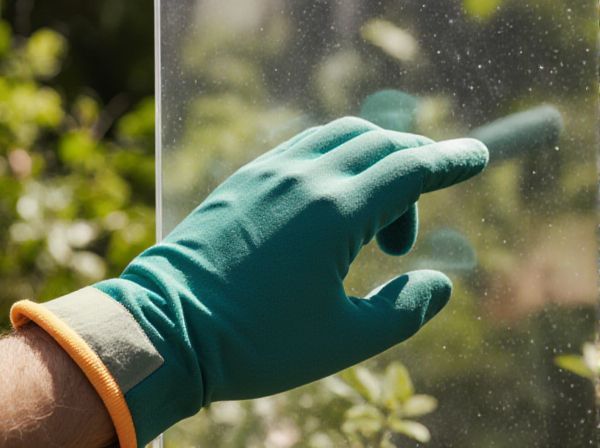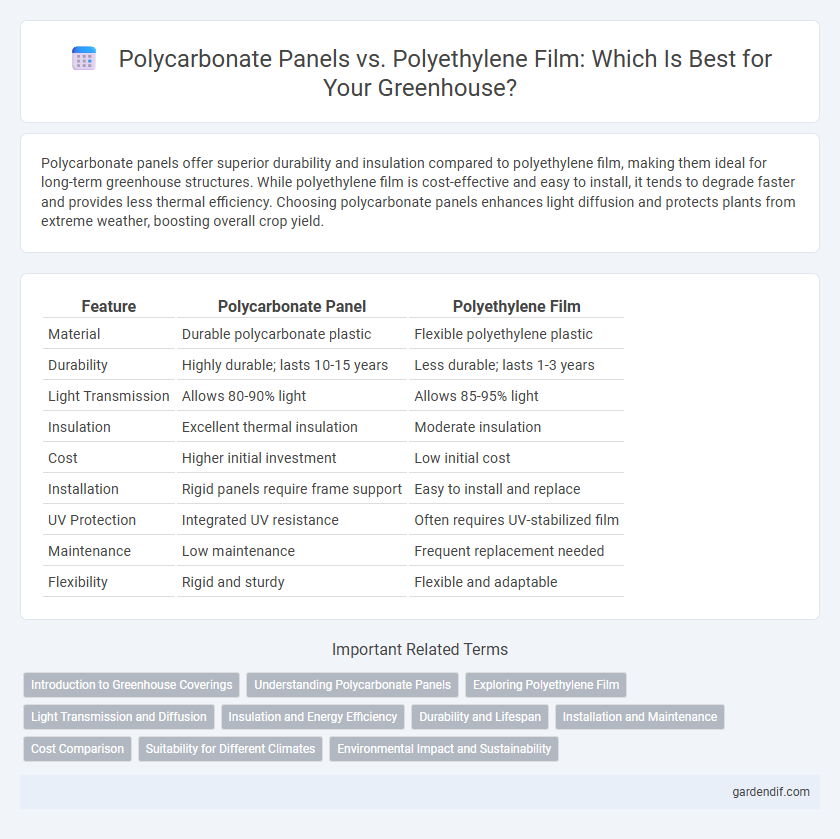
Polycarbonate Panel vs Polyethylene Film Illustration
Polycarbonate panels offer superior durability and insulation compared to polyethylene film, making them ideal for long-term greenhouse structures. While polyethylene film is cost-effective and easy to install, it tends to degrade faster and provides less thermal efficiency. Choosing polycarbonate panels enhances light diffusion and protects plants from extreme weather, boosting overall crop yield.
Table of Comparison
| Feature | Polycarbonate Panel | Polyethylene Film |
|---|---|---|
| Material | Durable polycarbonate plastic | Flexible polyethylene plastic |
| Durability | Highly durable; lasts 10-15 years | Less durable; lasts 1-3 years |
| Light Transmission | Allows 80-90% light | Allows 85-95% light |
| Insulation | Excellent thermal insulation | Moderate insulation |
| Cost | Higher initial investment | Low initial cost |
| Installation | Rigid panels require frame support | Easy to install and replace |
| UV Protection | Integrated UV resistance | Often requires UV-stabilized film |
| Maintenance | Low maintenance | Frequent replacement needed |
| Flexibility | Rigid and sturdy | Flexible and adaptable |
Introduction to Greenhouse Coverings
Polycarbonate panels provide durable, impact-resistant greenhouse coverings with excellent insulation and UV protection, ideal for long-term use and energy efficiency. Polyethylene films offer cost-effective, flexible solutions with high light transmission but require more frequent replacement due to lower durability. Selecting the appropriate greenhouse covering depends on balancing budget, climate control needs, and longevity.
Understanding Polycarbonate Panels
Polycarbonate panels offer exceptional thermal insulation and durability, making them ideal for greenhouse construction. Their UV-resistant surface protects plants from harmful radiation while allowing optimal light transmission for photosynthesis. Compared to polyethylene film, polycarbonate panels provide superior impact resistance and a longer lifespan, reducing maintenance and replacement costs.
Exploring Polyethylene Film
Polyethylene film offers high flexibility and excellent light transmission, making it an economical choice for greenhouse coverings compared to rigid polycarbonate panels. It provides effective insulation while allowing for easy installation and replacement, which is ideal for seasonal or temporary structures. Its UV-resistant properties enhance durability, contributing to optimal plant growth by maintaining consistent temperature and humidity levels.
Light Transmission and Diffusion
Polycarbonate panels provide superior light transmission, typically allowing 80-90% of sunlight to pass through, while offering excellent light diffusion to prevent hotspots and promote uniform plant growth inside greenhouses. Polyethylene films generally transmit around 85-90% of light but feature less effective diffusion properties, which can result in uneven illumination and potential plant stress. The high diffusion capability of polycarbonate panels ensures consistent photosynthesis rates and better crop yields in controlled environments.
Insulation and Energy Efficiency
Polycarbonate panels offer superior insulation properties compared to polyethylene film, reducing heat loss and maintaining a more stable internal greenhouse temperature. This increased thermal efficiency leads to significant energy savings by minimizing the need for supplemental heating during colder months. Polycarbonate's rigidity also supports better air sealing, enhancing overall energy efficiency in greenhouse environments.
Durability and Lifespan
Polycarbonate panels offer superior durability and a longer lifespan compared to polyethylene film in greenhouse applications, typically lasting 10 to 15 years due to their resistance to impact, UV rays, and weathering. Polyethylene films usually require replacement every 1 to 3 years as they are more prone to tearing, discoloration, and degradation from sun exposure. The enhanced strength and longevity of polycarbonate panels make them a more cost-effective option for long-term greenhouse covering.
Installation and Maintenance
Polycarbonate panels offer easy, rigid installation with snap-fit or screw systems that ensure durability and minimal frame adjustments, reducing setup time compared to flexible polyethylene film, which requires meticulous tensioning and anchoring to prevent sagging. Maintenance for polycarbonate panels involves periodic cleaning to preserve transparency and occasional inspection for cracks, while polyethylene film demands frequent replacement due to UV degradation, tears, and loss of clarity, increasing long-term upkeep costs. The structural stability and weather resistance of polycarbonate panels significantly lower maintenance frequency, making them a cost-effective choice for greenhouse construction.
Cost Comparison
Polycarbonate panels typically incur higher initial costs ranging from $15 to $30 per square foot, while polyethylene film averages $0.10 to $0.50 per square foot, making it a more budget-friendly option for greenhouse coverings. Although polycarbonate panels require a larger upfront investment, their durability and longevity, often lasting 10-20 years, can reduce replacement and maintenance expenses over time compared to polyethylene film, which usually needs annual replacement. Factoring in installation costs and lifespan, polycarbonate panels offer better long-term value despite the higher initial price.
Suitability for Different Climates
Polycarbonate panels offer superior insulation and durability, making them ideal for colder climates where heat retention and protection from harsh weather are crucial. Polyethylene film, being lightweight and flexible, performs well in moderate and warm climates, allowing better light diffusion and ventilation but less thermal insulation. Selecting the appropriate greenhouse covering depends on climate-specific factors such as temperature fluctuation, UV exposure, and wind resistance.
Environmental Impact and Sustainability
Polycarbonate panels offer superior durability and recyclability compared to polyethylene film, which degrades faster and generates more waste during disposal. The longer lifespan of polycarbonate reduces resource consumption and minimizes landfill contributions, enhancing overall greenhouse sustainability. Polyethylene film, while initially less energy-intensive to produce, requires frequent replacement, leading to increased cumulative environmental impacts over time.
Polycarbonate Panel vs Polyethylene Film Infographic

 gardendif.com
gardendif.com